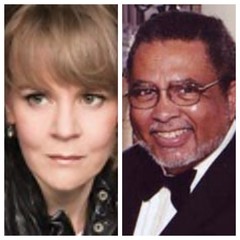|
Back
Urban klaxons and vernal birdcalls New York
Isaac Stern Auditorium, Carnegie Hall
01/06/2022 -
Adolphus Hailstork: An American Port of Call
John Adams: Saxophone Concerto
Jean Sibelius: Symphony No. 5 in E Flat Major, Opus 82
Branford Marsalis (Saxophone)
New York Philharmonic Orchestra, Susanna Mälkki (Conductor)

S. Mälkki/A. Hailstork
“If you like an instrument that sings, play the saxophone. At its best it’s like the human voice.”
Stan Getz (1927-1997)
“Don’t play the saxophone. Let it play you.”
Charlie Parker (1927-1955)
If John Adams’ Saxophone Concerto had a motto, it would be “Listen to how many hemidemisemiquavers my soloist can play in a single measure? And if you don’t believe, listen to how many hemidemisemiquavers can be multiplied in speed to play for every measure of a 30-minute saxophone extravaganza.”
Mr. Adams’ Concerto was one of three works conducted by the always welcome Finnish conductor Susanna Mälkki with the New York Philharmonic last night. She is one tough conductor, her orchestra last night is still among the most muscular in America. And in two-thirds of the concert, her muscularity was a joy.
Some, though, came to hear this new work by John Adams. And while suitably impressed–no, transfixed–by soloist Branford Marsalis–that was not enough to to plough through the dense orchestral texture or the technical morass,
Mr. Marsalis, the scion of a storied American heritage of great artists, was seemingly unaffected by all those notes given him by Mr. Adams. From the first fiery scale to the echo effects with the NY Phil, he essayed that seemingly endless cadenza as if her were playing Mary Had A Little Lamb. It was an astounding performance. And–unlike the Debussy rhapsody or Glazunov pedestrian Saxophone Concerto–John Adams’ work will go down as the Mount Everest of sax challenges.
My esteem for the artist is unabated. The whirling, buzzing, colliding notes of the music itself left me unmoved.
Not unmoving, though, Adolphus Hailstork’s paean to his home-town Newport, Virginia.
True, An American Port of Call started with identical chaos and klaxon horns of Gershwin’s American in Paris, had some direct quotes from Stravinsky’s Sacre, and at times resembled the dark and deep Copland Quiet City.
But one couldn’t deny that this work proceeded with security, color–and triumphal fun–for its all-too-short ten minutes. Mr. Hailstork presented an urban mélange, but it was cohesive, entertaining, and joyous.
The second half belonged to Ms. Mälkki, to her heritage and to an inner miracle. Jean Sibelius’ Fifth Symphony.
Ms. Mälkki's affection for the work was not as a compatriot of the composer–but one who understood the nature pictures here. From the gorgeous horn solo through to the great flock of geese ascending was a tribute to the tone-painting of the composer.
Not once was this opening gentle or leisurely: it was a primordial nature of bird-calls, deep woodsy breezes and the preternatural sunrise.
The second movement was not merely a poetic interlude. Like the opening, each instrument was pointed, each measure dovetailed into the next, and the sudden ending lifted us all to the glorious finale.
What gave Ms. Mälkki such a thrill was not overbearing elegance, certainly not a quaint look at the Finnish forests.
Rather, she conducted it with an energy, a persistence and a delight into the New York Philharmonic forces. They in turn took an equal delight in a conductor who appreciated their great power.
Harry Rolnick
|